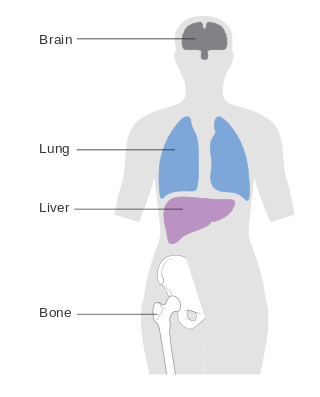Related Research Articles

A brain tumor occurs when abnormal cells form within the brain. There are two main types of tumors: malignant tumors and benign (non-cancerous) tumors. These can be further classified as primary tumors, which start within the brain, and secondary tumors, which most commonly have spread from tumors located outside the brain, known as brain metastasis tumors. All types of brain tumors may produce symptoms that vary depending on the size of the tumor and the part of the brain that is involved. Where symptoms exist, they may include headaches, seizures, problems with vision, vomiting and mental changes. Other symptoms may include difficulty walking, speaking, with sensations, or unconsciousness.

Metastasis is a pathogenic agent's spread from an initial or primary site to a different or secondary site within the host's body; the term is typically used when referring to metastasis by a cancerous tumor. The newly pathological sites, then, are metastases (mets). It is generally distinguished from cancer invasion, which is the direct extension and penetration by cancer cells into neighboring tissues.
Radionuclide therapy uses radioactive substances called radiopharmaceuticals to treat medical conditions, particularly cancer. These are introduced into the body by various means and localise to specific locations, organs or tissues depending on their properties and administration routes. This includes anything from a simple compound such as sodium iodide that locates to the thyroid via trapping the iodide ion, to complex biopharmaceuticals such as recombinant antibodies which are attached to radionuclides and seek out specific antigens on cell surfaces.

Anaplastic thyroid cancer (ATC), also known as anaplastic thyroid carcinoma, is an aggressive form of thyroid cancer characterized by uncontrolled growth of cells in the thyroid gland. This form of cancer generally carries a very poor prognosis due to its aggressive behavior and resistance to cancer treatments. The cells of anaplastic thyroid cancer are highly abnormal and usually no longer resemble the original thyroid cells and have poor differentiation.

Miltefosine, sold under the trade name Impavido among others, is a medication mainly used to treat leishmaniasis and free-living amoeba infections such as Naegleria fowleri and Balamuthia mandrillaris. This includes the three forms of leishmaniasis: cutaneous, visceral and mucosal. It may be used with liposomal amphotericin B or paromomycin. It is taken by mouth.

Monoclonal antibody therapy is a form of immunotherapy that uses monoclonal antibodies (mAbs) to bind monospecifically to certain cells or proteins. The objective is that this treatment will stimulate the patient's immune system to attack those cells. Alternatively, in radioimmunotherapy a radioactive dose localizes a target cell line, delivering lethal chemical doses. Antibodies have been used to bind to molecules involved in T-cell regulation to remove inhibitory pathways that block T-cell responses. This is known as immune checkpoint therapy.
In cell biology, a lymphokine-activated killer cell is a white blood cell that has been stimulated to kill tumor cells. If lymphocytes are cultured in the presence of Interleukin 2, it results in the development of effector cells which are cytotoxic to tumor cells.

Iobenguane, or MIBG, is an aralkylguanidine analog of the adrenergic neurotransmitter norepinephrine (noradrenaline), typically used as a radiopharmaceutical. It acts as a blocking agent for adrenergic neurons. When radiolabeled, it can be used in nuclear medicinal diagnostic and therapy techniques as well as in neuroendocrine chemotherapy treatments.

Retinal pigment epithelium-specific 65 kDa protein, also known as retinoid isomerohydrolase, is an enzyme of the vertebrate visual cycle that is encoded in humans by the RPE65 gene. RPE65 is expressed in the retinal pigment epithelium and is responsible for the conversion of all-trans-retinyl esters to 11-cis-retinol during phototransduction. 11-cis-retinol is then used in visual pigment regeneration in photoreceptor cells. RPE65 belongs to the carotenoid oxygenase family of enzymes.

Efaproxiral (INN) is an analogue of the cholesterol drug bezafibrate developed for the treatment of depression, traumatic brain injury, ischemia, stroke, myocardial infarction, diabetes, hypoxia, sickle cell disease, hypercholesterolemia and as a radio sensitiser.

Metastatic breast cancer, also referred to as metastases, advanced breast cancer, secondary tumors, secondaries or stage IV breast cancer, is a stage of breast cancer where the breast cancer cells have spread to distant sites beyond the axillary lymph nodes. There is no cure for metastatic breast cancer; there is no stage after IV.

Minigastrin is a form of gastrin. Its sequence is H-Leu-Glu-Glu-Glu-Glu-Glu-Ala-Tyr-Gly-Trp-Met-Asp-Phe-NH2.
Microbubbles (MBs) are bubbles smaller than one hundredth of a millimetre in diameter, but larger than one micrometre. They have widespread application in industry, life science, and medicine. The composition of the bubble shell and filling material determine important design features such as buoyancy, crush strength, thermal conductivity, and acoustic properties.

A brain metastasis is a cancer that has metastasized (spread) to the brain from another location in the body and is therefore considered a secondary brain tumor. The metastasis typically shares a cancer cell type with the original site of the cancer. Metastasis is the most common cause of brain cancer, as primary tumors that originate in the brain are less common. The most common sites of primary cancer which metastasize to the brain are lung, breast, colon, kidney, and skin cancer. Brain metastases can occur in patients months or even years after their original cancer is treated. Brain metastases have a poor prognosis for cure, but modern treatments are allowing patients to live months and sometimes years after the diagnosis.

Plus Therapeutics, Inc. is a clinical-stage pharmaceutical company developing innovative, targeted radiotherapeutics for adults and children with rare and difficult-to-treat cancers. The company is headquartered in Austin, Texas, United States.

Temozolomide (TMZ), sold under the brand name Temodar among others, is a medication used to treat brain tumors such as glioblastoma and anaplastic astrocytoma. It is taken by mouth or via intravenous infusion.
Edelfosine is a synthetic alkyl-lysophospholipid (ALP). It has antineoplastic (anti-cancer) effects.

Sonodynamic therapy (SDT) is a noninvasive treatment, often used for tumor irradiation, that utilizes a sonosensitizer and the deep penetration of ultrasound to treat lesions of varying depths by reducing target cell number and preventing future tumor growth. Many existing cancer treatment strategies cause systemic toxicity or cannot penetrate tissue deep enough to reach the entire tumor; however, emerging ultrasound stimulated therapies could offer an alternative to these treatments with their increased efficiency, greater penetration depth, and reduced side effects. Sonodynamic therapy could be used to treat cancers and other diseases, such as atherosclerosis, and diminish the risk associated with other treatment strategies since it induces cytotoxic effects only when externally stimulated by ultrasound and only at the cancerous region, as opposed to the systemic administration of chemotherapy drugs.
Patient derived xenografts (PDX) are models of cancer where the tissue or cells from a patient's tumor are implanted into an immunodeficient or humanized mouse. PDX models are used to create an environment that allows for the natural growth of cancer, its monitoring, and corresponding treatment evaluations for the original patient.
Sheila K. Singh MD, PhD, FRCSC is a chief pediatric neurosurgeon at McMaster Children's Hospital in Ontario, Canada. She is also Professor of Surgery and Biochemistry, the Division Head of Neurosurgery at Hamilton Health Sciences, the Research Director for McMaster's Division of Neurosurgery, and a scientist/principal investigator appointed to the Stem Cell and Cancer Research Institute at McMaster University.
References
- ↑ Unger C, Sindermann H, Peukert M, Hilgard P, Engel J, Eibl H (1992). "Hexadecylphosphocholine in the topical treatment of skin metastases in breast cancer patients". Progress in Experimental Tumor Research. Fortschritte der Experimentellen Tumorforschung. Progrès de la Recherche Expérimentale des Tumeurs. Progress in Tumor Research. 34: 153–9. doi:10.1159/000420840. ISBN 978-3-8055-5464-0. PMID 1438798.
- ↑ Zeisig R, Jungmann S, Fichtner I, Daemen T, Arndt D (1994). "Cytotoxic effects of alkylphosphocholines or alkylphosphocholine-liposomes and macrophages on tumor cells". Anticancer Research. 14 (5A): 1785–9. PMID 7847811.
- ↑ Dietrich Arndt; Reiner Zeisig; Ines Eue & Iduna Fichtner (1995). "Alkylphosphocholines and Alkylphosphocholine Liposomes". Journal of Liposome Research. 5 (1): 91–98. doi:10.3109/08982109509039910.
- ↑ Clark, Paul A.; Al-Ahmad, Abraham J.; Qian, Tongcheng; Zhang, Ray R.; Wilson, Hannah K.; Weichert, Jamey P.; Palecek, Sean P.; Kuo, John S.; Shusta, Eric V. (2016-09-06). "Analysis of Cancer-Targeting Alkylphosphocholine Analogue Permeability Characteristics Using a Human Induced Pluripotent Stem Cell Blood–Brain Barrier Model". Molecular Pharmaceutics. 13 (9): 3341–3349. doi:10.1021/acs.molpharmaceut.6b00441. ISSN 1543-8384. PMC 5014630 . PMID 27421304.
- 1 2 3 Jendrossek, Verena; Hammersen, Kerstin; Erdlenbruch, Bernhard; Kugler, Wilfried; Krügener, Regina; Eibl, Hansjörg; Lakomek, Max (2002-07-01). "Structure-activity relationships of alkylphosphocholine derivatives: antineoplastic action on brain tumor cell lines in vitro". Cancer Chemotherapy and Pharmacology. 50 (1): 71–79. doi:10.1007/s00280-002-0440-8. ISSN 1432-0843. PMID 12111115. S2CID 25081528.
- ↑ Weichert, Jamey P.; Clark, Paul A.; Kandela, Irawati K.; Vaccaro, Abram M.; Clarke, William; Longino, Marc A.; Pinchuk, Anatoly N.; Farhoud, Mohammed; Swanson, Kyle I.; Floberg, John M.; Grudzinski, Joseph (2014-06-11). "Alkylphosphocholine Analogs for Broad-Spectrum Cancer Imaging and Therapy". Science Translational Medicine. 6 (240): 240ra75. doi:10.1126/scitranslmed.3007646. ISSN 1946-6234. PMC 4336181 . PMID 24920661.
- ↑ Eibl, Kirsten H.; Banas, Bernhard; Schoenfeld, Carlo-L.; May, Christian A.; Neubauer, Aljoscha S.; Priglinger, Siegfried; Kampik, Anselm; Welge-Lussen, Ulrich (2003-08-01). "Alkylphosphocholines Inhibit Proliferation of Human Retinal Pigment Epithelial Cells". Investigative Ophthalmology & Visual Science. 44 (8): 3556–3561. doi:10.1167/iovs.02-1172. ISSN 1552-5783. PMID 12882807.